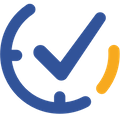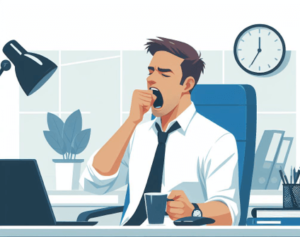Many of us have battled the infamous 2 PM energy crash countless times. Picture a freelance writer staring blankly at their computer screen, fingers hovering motionless over the keyboard. The words needed to finish an important article seem to have vanished into thin air, along with motivation and creativity. This scenario is all too common for those facing the midday slump. Let’s explore why it happens and how to beat it!
The Midday Slump: More Than Just Feeling Sleepy
We’ve all been there. One minute you’re powering through your to-do list, and the next, you’re fighting to keep your eyes open. But what exactly is going on?
1. Biology’s Sneaky Siesta: Our circadian rhythm, which regulates various physiological processes, experiences a natural dip in the early afternoon hours. This dip can lead to increased sleepiness and reduced alertness, often referred to as the “afternoon slump.”
2. The Food Coma Phenomenon: When we consume a large meal, our body prioritizes digestion by increasing blood flow to the digestive system. This redirection of blood flow can result in decreased blood supply to the brain, potentially causing feelings of drowsiness and reduced cognitive performance.
3. Natural Energy Ebb: Even in the absence of a heavy meal, our bodies tend to experience a natural decline in energy and alertness during the afternoon hours. This phenomenon is part of our body’s normal circadian rhythm and can affect productivity and focus regardless of our eating habits.
For me, the slump usually hit around 2:30 PM. I’d find myself:
– 😴 Yawning uncontrollably, as if I hadn’t slept in days
– 🧠 Staring at my screen, unable to form coherent sentences
– 📉 Rethinking career path. Pro napper sounds tempting
– 💡 Watching my creativity pack its bags and head for the hills

Strategies for Overcoming Afternoon Productivity Slumps
Nutritional and Physiological Approaches
1. Manage Your Hydration: Keep your cognitive function sharp by maintaining adequate hydration. Keep a water bottle at your workstation and aim to drink consistently throughout your day. You might find that adding natural flavor enhancers, like citrus fruits or herbs, increases your water consumption.
2. Choose Nutrient-Dense Snacks: Prevent energy crashes by maintaining your blood sugar levels. Keep a selection of nutrient-rich snacks within your reach to deter less healthy choices. Options like nuts, seeds, dark chocolate, and dried fruits can provide you with a balance of proteins, healthy fats, and complex carbohydrates.
3. Optimize Your Lunch Choices: Heavy, carb-rich lunches often contribute to your afternoon drowsiness. Lighter meals focusing on lean proteins and vegetables can provide you with sustained energy without inducing fatigue. You might find that salads with a protein source offer an ideal balance for your midday meal.
4. Explore Alternative Caffeine Sources: While coffee is a common afternoon pick-me-up, you might get better results with green tea or matcha. These alternatives contain L-theanine, which can promote a state of calm alertness without the potential jitters you might associate with coffee.
5. Increase Your Light Exposure: Boost your alertness by getting brief exposure to natural light. Take a short outdoor break after your lunch, even in bad weather, to get both fresh air and beneficial light exposure.
6. Keep Your Body Moving: Combat fatigue from prolonged sitting by implementing regular movement breaks. Stretch or take brief walks hourly to improve your circulation and energy levels.

Cognitive Rejuvenation Techniques
1. Try Strategic Napping: If your work environment allows, short power naps (typically 10-20 minutes) can significantly boost your cognitive function. Ensure proper nap hygiene by using sleep masks and reliable alarms to avoid oversleeping.
2. Vary Your Environment: Stimulate your mind by changing your work location, even within the same office. You might find that occasional work sessions in different settings, such as meeting rooms or quiet areas, can enhance your focus.
3. Use Auditory Stimulation: Influence your mood and energy levels with carefully selected music. Create playlists designed to promote your focus and alertness as an effective tool for maintaining productivity.
4. Challenge Your Mind: Reactivate your mental processes by briefly engaging in problem-solving activities or puzzles. Simple tools like Rubik’s cubes or short brain teasers can effectively serve this purpose for you.
5. Practice Breathing Exercises: Reduce your stress and improve your focus with techniques like the 4-7-8 breathing method (inhale for 4 counts, hold for 7, exhale for 8). Use these practices as a quick mental reset during your workday.
6. Embrace Mindfulness: Enhance your concentration and mental clarity with short guided meditations or mindfulness exercises, often available through mobile applications. Even brief 3-5 minute sessions can yield noticeable benefits for your productivity.

The midday slump is real, but it doesn’t have to control your day. By understanding your body’s rhythms and finding personalized strategies, you can maintain high energy levels from 9 to 5 (and beyond). Experiment, be patient with yourself, and don’t be afraid to get a little silly (office dance party, anyone?). With time and practice, you’ll become the master of your afternoon energy. Now, if you’ll excuse me, it’s time for my sunshine break and a quick stretch session.




